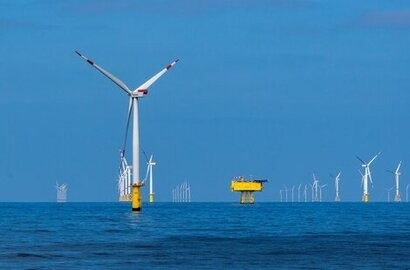
Vineyard Wind is currently constructing America’s first utility-scale offshore wind energy project at a site located over 15 miles off the coast of Massachusetts. The project will could potentially generate enough renewable energy for over 400,000 homes and businesses across the Commonwealth, displacing over 1.6 million tons of carbon per year.
The project consists of 62 General Electric Haliade-X wind turbines, aligned on an east-west and north south orientation, spaced 1 nautical mile apart. Each wind turbine is capable of generating 13 MW of electricity, with the full amount of power being collected by an offshore substation and then transmitted to shore.
A final environmental impact statement (FEIS) relating to the project was released in March 2021, but approval was delayed by the Trump administration, citing concerns about fishing and safety. The Biden administration subsequently fast-tracked the project upon taking office and final major federal approval was granted on May 11, 2021. However, several months after the approval, the Responsible Offshore Development Alliance, which represents fishing interests, launched a federal lawsuit disputing it. A group of Nantucket residents did likewise in January 2023 and so too did solar energy competitor Allco Renewable Energy. Construction persisted despite these lawsuits. The project expects to be able to start generating electricity by the end of 2023 with the final turbines being installed in 2024.
“The District Court held that the Bureau of Ocean Energy Management (BOEM) and the National Marine Fisheries Service (NMFS) fully complied with the Endangered Species Act (ESA) and the National Environmental Policy Act (NEPA) in approving what is about to become the largest offshore wind farm in the United States” said Josh Kaplowitz, ACP Vice President of Offshore Wind. “This opinion validates what we’ve been saying all along: the environmental review process for offshore wind projects is rigorous and effective at ensuring that these projects are built in an environmentally responsible manner. The federal government did its job, and they did it well.”
The District Court agreed with BOEM and NMFS that the best available science was considered in protecting the endangered North Atlantic Right Whale (NARW) and approving the project with an extensive suite of mitigation measures to reduce risk to the species. The court rejected all of the plaintiffs’ claims that the federal agencies had failed to analyse certain studies and data relating to the NARW.
“We know that offshore wind farms can be built and operated in a way that protects marine ecosystems” added Josh Kaplowitz. “Now it’s time to get steel in the water and start reaping the significant benefits that offshore wind affords: reducing greenhouse gas emissions, improving our nation’s health, powering millions of homes with secure and reliable domestic energy, revitalising our maritime and manufacturing sectors, and creating tens of thousands of good-paying American jobs.”
The District Court is expected to issue opinions in the coming weeks regarding two other challenges to the Vineyard Wind project. However, ACP stresses this opinion bodes well for the ability of this nascent industry to stand up to legal challenges from opponents of clean energy.
For additional information:

